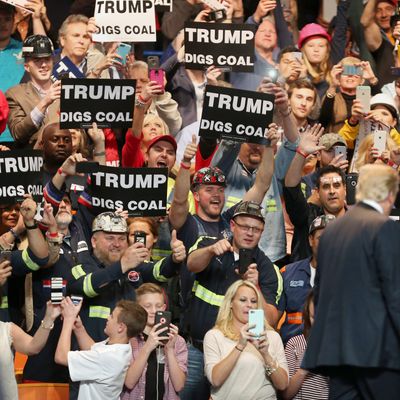
Anyone following the 2016 presidential campaign is likely aware that a lot of people in communities that produce (or used to produce) coal loved Donald Trump’s promises to get rid of all those stupid environmental rules and bring back the mines to their former glory. And more generally, Trump’s hostility to policies based on the science indicating potentially catastrophic climate change was hardly a secret.
But as we watch Trump’s cabinet fill with climate-change deniers and former fossil-fuel CEOs and sundry enemies of all things green, it makes sense to look for a deeper connection between attitudes toward the burning of fossil fuels and presidential preferences. That is what Ron Brownstein did in ranking the states by per capita carbon emissions. Turns out there is a very high correlation between how many dinosaurs a state burns up and its tendency to vote for Trump:
Trump carried all of the 22 states with the most per capita carbon emissions, except for New Mexico, and 27 of the top 32 in all. (Colorado, Illinois, Delaware, and Minnesota were the Clinton-voting exceptions.) The Democratic nominee won 15 of the 18 states with the lowest per capita emissions—with the exception of Florida, North Carolina, and Idaho.
And if you look at the states (other than Florida) that flipped from Obama ’12 to Trump ’16, there’s an even more striking correlation:
[A]mong the top 32 emitters, five Rustbelt states that Obama won last time flipped to Trump: Iowa, Ohio, Pennsylvania, Wisconsin, and Michigan.
Now the tendency to “emit” is itself correlated with some more familiar factors that divided the country between Clinton and Trump voters. Aside from including states that produce carbon-emitting energy and its products, the emitters also include manufacturing states that disproportionately consume such products. And there’s this:
The high-carbon states—centered on the Plains, the Mountain West, and portions of the South—also tend to be more rural, more religiously traditional, and often less racially diverse than the low-carbon states.
And low-carbon states tend to rely more on digital industries and are more urban and demographically diverse in character. So it all fits together.
But what a look at these energy correlations really shows is how powerful an incentive the Trump administration has for “drill, baby, drill” policies. It’s basically a matter of reflecting the views and perceived interests of the Trump constituencies at the expense of others. Add in the fact that rapid expansion of the use of fossil fuels is one of the main conservative theories for how to produce rapid economic growth, and you’ve got a must-do agenda item.
If climate-change science is correct, of course, the economic benefits of a move back toward fossil fuels will be limited and very quickly counterproductive, especially if the rest of the world continues to move in the opposite direction. But there is always a constituency for doing the wrong thing, and in this case, it has a lot of electoral votes.






























